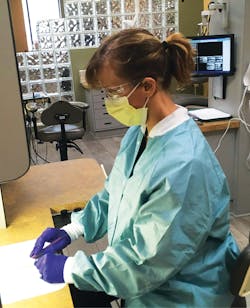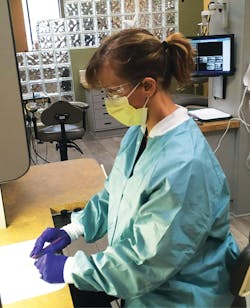DIY, or get the service?
The sharpening of dental hygiene instruments is more important than ever, but which option?
By Pat Pine, RDH, COM
Have you ever shaved your legs only to find out that the razor was dull, and every other hair was sticking up like a thorn? Did you Miss the back of your leg beside the ankle? Frustrating, isn’t it?
Working with dull instruments is a similar dialogue. What are we leaving behind that we can’t see? Scaling to perfection is not easy when operating with dull equipment.
Imagine that the patient arrives for scaling and root planing. The instruments are earmarked just for this type of treatment in a special cassette. You grab the sterilized cassette of instruments to set up the room. The patient is seated, and medical history and blood pressure are taken. The oral cancer screening is performed, and now we are set to scale. Many patients have very tedious tenacious subgingival calculus that we love to remove. We are detailed and love a challenge, right? One, it’s for the patient; two, we love what we do; three, it’s the ethical thing to do for this scheduled treatment.
As you are scaling this tenacious calculus, you find it is not coming off—Cavitron, hand scaling, Cavitron, hand scaling—it is not budging. The scalers seem to be very dull and might chip away the top layers of this hard barnacle-like infectious material, but that is not going to do the trick once it’s anchored to the cementum. These bacteria have the potential to cause infection, not only in the patients gum tissue but also their physical health (heart, lungs, etc.).
When to sharpen?
Sharpening is a lost art, in my opinion. Who has the time to sharpen? Yes, when there is downtime. Yes, when a patient is a no-show, which rarely happens with all the new texting technology to keep the dental chairs occupied with a warm body.
Doctors don’t like to see hygienists sharpen instruments; they prefer a patient in the chair for production. Many doctors don’t understand the struggles of calculus removal that hygienists provide for their patients.
Sharpening hygiene instruments is only one critical segment to providing high quality care. Our patients trust that we are removing all the “barnacles” off their teeth. Since other team members typically cannot sharpen on a whim, they can confirm patient appointments, keep sterilization up and running, and assist in other aspects of keeping the office running smoothly. Many of us want to sharpen our own instruments. We are then responsible for their sharpness and safety. Scalers or curettes should be removed out of circulation when dull.
The properties of a sharp instrument:
• Saves time and cost
• Greater precision for when instrument meets calculus
• Less trauma on hands, wrists, neck, and shoulders
• Less trauma on patient
• Greater control with instrument
• Better ergonomics through grip and comfort
• Reduces stress on hygienist who does not have time to sharpen
Hazards of a dull instrument:
• Slipping off the tooth while scaling, possibly injuring a finger
• Inefficient and ineffective treatment
• Reduces patient and operator comfort level
• Cramps and fatigue of wrists, hands, and fingers
• Increased pressure, leading to longer duration of treatment and exhaustion of the human body
• Leaving burnished calculus on tooth surface, flattened concealed bacteria (additional recurrence of treatment)
• Reduces tactile touch of the hygienist
Dental hygiene education focuses on major learning objectives. The instrument sharpening class is not at the forefront of importance; it needs to have more significance in all schools. All instruments must be sterilized before sharpening for a variety of reasons. One specific reason is if, while sharpening, the instrument slips and injures a finger. It then becomes an exposure to bioburden and possible dangerous spores. If sharpening chairside, the risk of exposure is very high should the instrument slip and penetrate your tissues. This would be considered an exposure that would require post-exposure protocol.
Sharpening Options
Disposable options are available in office situations where there is no such thing as being too costly. In addition, other offices can use a sharpening service such as those offered, for example, by Hu-Friedy, Goldman Dental, Nordent, and Paragon Instruments.
Of course, the DIY approach to instrument sharpening remains practical, as long as dental offices recognize the improved efficiency that comes with sharper instruments. Several motorized dental instrument sharpeners are available. Dental hygienists can take sharpening courses to update skills.
Several trade-in services expedite the transition from dull instruments to new ones. External services also will repair instruments, as they have done in the past.
Digital resources such as sharpening videos on the internet also help. YouTube videos, for example, are available to tune-up your instrument sharpening skills that may be taking time away from patient care.
The types of DIY sharpening tools are still broken down into three categories: acrylic test stick, flat stones, or a specific sharpening bur with a high-speed handpiece. The flat stones are typically a white stone or a red stone. Some guides such as the Gleason Guide (PDT) offer quick assistance to practitioners who are sharpening off a stone.
Shofu offers a friction-grip small stone, cone-shape bur. Its green stone abrasive is used for very dull instruments, as well as a white stone.
Some examples of automated sharpening systems include PerioStar 3000 (Kerr Dental), Sidekick Sharpener (Hu-Friedy), InstRenew Sharpening Assistant (Nordent), and Autoclavable D.I.S.C. (Premier Dental). The PerioStar does not rely on human intervention. The dull instrument is secured into the device while sharpening takes place. The Sidekick runs on batteries and assists in controlling blade angulation with instrument guide channels and a backstop. A foot switch is available for InstRenew. As implied by its name, D.I.S.C. has autoclavable components.
In the best interest of the clinician’s eyes, some type of magnification is recommended in order to see the detailed angle on blades on a variety of instruments. Loupes are used to protect and assist in detecting supragingival calculus with the naked eye. We need the same type of detailed vision when sharpening instruments.
Sharpening or servicing?
Many hygienists send their instruments out to be sharpened. Yes, there is cost to this. It outweighs the time and effort. Instrument services should be budgeted into the hygiene department funds. New instruments if ordered monthly (trade-in or replacement) do not become a burden on the budget.
Often, when a hygienist is not confident in her sharpening skills, he or she delays sharpening until the bitter end. Some instruments are reconfigured from nice round toe curettes to sharp pointy-poky scalers. These instruments become dangerous to the patients’ gingival tissues.
I have seen instruments where both sides of a curette have been sharpened, when only one edge is the cutting blade.
We all have our favorite instruments. Many hygienists won’t share their instruments, and we are very protective of the instruments we use. Ultrasonic scalers have taken some of the load off our hands but are not detailed enough to remove that tenacious bacteria that our tactile sensitivity can feel. Some hygienists prefer to purchase their own personal instruments; that is a conversation between a clinician and doctor-employer.
Not having sharp instruments is like not tuning up your car when needed. Doctors need sharp burs to cut through enamel at a blink of an eye to complete their treatment efficiently and effectively. Dental burs are now disposable, so their treatment is not challenging as that of a hygienist. Dull instruments interfere with career longevity, causing strain on hands, neck, shoulders, and back pain. It’s time to review what is best for you the clinician and the hygiene department budget. Dull is out; sharp is in for best practices for less wear and tear on the hygiene body.
Patricia Pine, RDH, COM, is a national and international speaker on topics including Occupational Safety and Health Administration (OSHA) safety, infection prevention, and orofacial myology. She conducts in-office OSHA boot camps and seminars for the dental community, and she is a member of the Organization for Safety, Asepsis and Prevention (OSAP) speaker’s consultant bureau. She can be reached at [email protected] or OSHAtrainingbootcamp.com.

